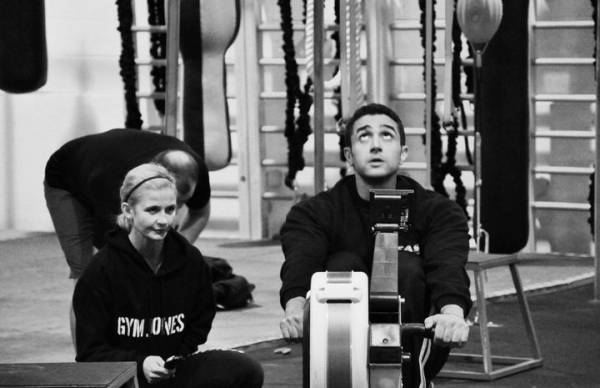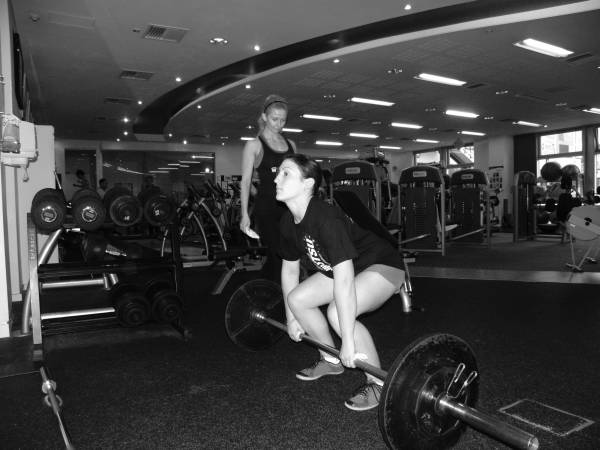The following is written by Sabina Skala, a featured coach here on Breaking Muscle. Click here to get started on her four weeks of free MMA-oriented workouts.
“Size matters not. Look at me. Judge me by size, do you?” – Yoda, Star Wars
I Don’t Want To Get Bulky
Can you get stronger without getting bigger and heavier? Most combat athletes need to cut weight before the fights. Weight control is often crucial for them, so this question of size versus strength becomes important. Therefore my focus in this article is to give you simple training tips of how to get stronger without getting bigger.
You can find thousands of articles on neuromuscular adaptations to strength training. The adaptations are called neuromuscular for a reason. A lot of people associate strength with size. If I tell you that X is the strongest man I have ever met, what picture comes to your head? Would it be big man with huge muscles protruding through his clothes, or medium-built, athletic guy? Probably the first one. It may be, but does not necessarily have to be true. Size matters if you want to be the strongest man on earth. Strongman competitors are big for a reason. However, if you remember my fellow countryman Mariusz Pudzianowski, five time World’s Strongest Man winner, you will know that he was probably one of the smallest guys out there.
Strength Is A “Skilled Act”
Your body adapts to training and gets stronger/bigger/faster/smaller because of the neural, muscular, hormonal, and skeletal changes that are the result of chosen training stimulus. Is it possible, then, to get stronger without getting bigger? Yes, it is. It all depends how strong one wants to be. I came across an article on the Internet a while ago. The author described strength as a “skilled act.” I really liked this description, as it implies you can teach your body to be strong.
To start, let us focus on sports that require great amounts of strength and/or power and at the same time involve weight limitations – combat sports (i.e. boxing, MMA, BJJ), gymnastics, ballet (Yes, I do consider ballet dancers athletes), ice skating, and climbing. While sports like boxing or MMA have explicit weight groups, in other sports like ice-skating, climbing, dance and gymnastics the lighter and stronger you are the better off you are.
 Training all of the above, or even training women (“I don’t want to get bulky” is probably what personal trainers hear first from most female clients) should focus mostly on the neural adaptations to strength training. Let me make it clear – research shows it is not possible to induce only neural or only muscular changes. Both always take place, but there are certain protocols that allow increases in strength with minimum increase in the muscle cross section.
Training all of the above, or even training women (“I don’t want to get bulky” is probably what personal trainers hear first from most female clients) should focus mostly on the neural adaptations to strength training. Let me make it clear – research shows it is not possible to induce only neural or only muscular changes. Both always take place, but there are certain protocols that allow increases in strength with minimum increase in the muscle cross section.
The initial strength gains when you start strength training come mostly from neuromuscular adaptations rather than hypertrophy. If you notice your muscles “pump up” during or shortly after the session, don’t panic or be too happy (depending of what your goal is). This is a short term increase in size caused by fluid retention. It should fade away within 60-90 mins after the training.
Lets look at the main mechanisms of neural adaptation:
1. Increased Motor Unit Recruitment
This means neural adaptation to training that rapidly increases the strength of a novice who hasn’t yet experienced hypertrophy. What is a motor unit? A motor unit is made up of a single motor neuron, as well as all of the muscle fibers that neuron activates. This refers to our skeletal muscles, which are made of hundreds of thousands of fibers. These muscle fibers are activated by motor neurons when they receive signals from the brain to contract the muscle. A single motor neuron can control several hundred muscle fibers at a time, depending on the size and function of the muscle.
Why is it good to recruit more motor units and how does it relates to strength gains? Even when you engage in very low intensity activities, like lifting a glass to your mouth, your brain recruits motor units that have a smaller number of muscle fibers to allow you to lift the glass. However, when you are lifting something extremely heavy or applying a lot of force your body will contract more available motor units to allow you to perform the activity.
 Your brain is a very clever mechanism. Imagine what would happen if your brain told your muscles to contract fully when lifting a glass up. You’d be knocking yourself in the face every time you wanted to have a drink. Motor unit recruitment is a trained and learned ability. The more motor units you can recruit, the more muscle fibers you can activate. The more muscle fibers you can activate, the more force you can apply.
Your brain is a very clever mechanism. Imagine what would happen if your brain told your muscles to contract fully when lifting a glass up. You’d be knocking yourself in the face every time you wanted to have a drink. Motor unit recruitment is a trained and learned ability. The more motor units you can recruit, the more muscle fibers you can activate. The more muscle fibers you can activate, the more force you can apply.
2. Coordination of Motor Unit Recruitment
As mentioned above – as the athlete training progresses, his or her ability to utilize multiple motor units increases. Please note that each muscle fiber in a motor unit is functionally identical, which means it is either slow twitch or fast twitch, never both in the single motor unit. Training increases the total number of motor units that affect a muscular contraction. In other words, trained individuals can recruit more motor units than novices.
3. Increased Frequency of Firing
The frequency of motor unit firing increases with the training, as well as the total number of motor units that affect a muscular contraction. More motor units work together and they fire more rapidly (faster).
4. Improved Technique and Skill Acquisition
Out of the two similarly sized men, the one whose technique is competent will be able to generate more force than the novice. Also, he will do so in a safer manner.
5. Cross Education
Increased involvement of the neural pathways contributes to strength gains, too. For example, an untrained arm will gain significant strength in concert with a trained arm because of interaction between the nerves of either arm at the spinal column. This cross-education is one of the clearest demonstrations of neural adaptation.
Best Exercises for Strength Development
So now you understand the theory and you want to put this into practice. What exercises are best for this sort of strength development? My six fundamental exercises are:
- Deadlift
- Front Squat
- Overhead Squat
- Pull Up (weighted or not)
- Military Press
- Push Up (weighted or not)
- + (extra / optional) Bench Press
Reps, Sets, Rest, and Load Percentages For Strength Gain
Once an athlete’s form is proficient in all of the above, then we can start playing with variations. The chart below (taken from Mel Siff’s Supertraining) will explain the repetitions range you should be aiming for depending on what your goal is.
| Variable | Strength | Power | Hypertrophy
(mass gain) |
Endurance
(local muscle endurance) |
| Load (% 1RM) | 80-100 | 70-100 | 60-80 | 40-60 |
| Repetitions | 1-5 | 1-5 | 8-15 | 25-60 |
| Sets | 4-7 | 3-5 | 4-8 | 2-4 |
| Rest btw sets (minutes) | 2-6 | 2-6 | 2-5 | 1-2 |
Even more detailed guidelines as per The Kinesiology of Exercise by Michael Yessis:
- 1-4 reps per set @ 2-4RM increase pure strength but do not increase muscle mass
- 4-9 reps per set @ 5-9RM increase strength together with muscle mass
- 10-15 reps per set increase muscular strength, muscular endurance and muscle mass
- 16-30 reps per set increase muscular endurance with little to no increase in muscle mass
- 31-50 reps per set or circuit increase muscular endurance with no effect on muscle mass
- 50-100 reps per set or circuit increase muscular endurance, cardio-respiratory endurance, and there will be a possible loss of muscle mass (or fat) but absolutely no increase in strength
For Best Training Results, Consistency Is Key
With all the guidelines above, just remember to stick to the numbers and be consistent and honest with your training. Be honest with yourself. If poor technique or mobility hinders you from lifting heavier, don’t stack more weight on the bar. Work on technique and mobility, as this is the problem. Changes will happen, as long as you are smart about your training and forget about the ego.
Click here to get started on your four weeks of free MMA-oriented workouts. To learn more about the philosophy behind these workouts, read Sabina’s article, How to Train Strength and Conditioning for MMA.






